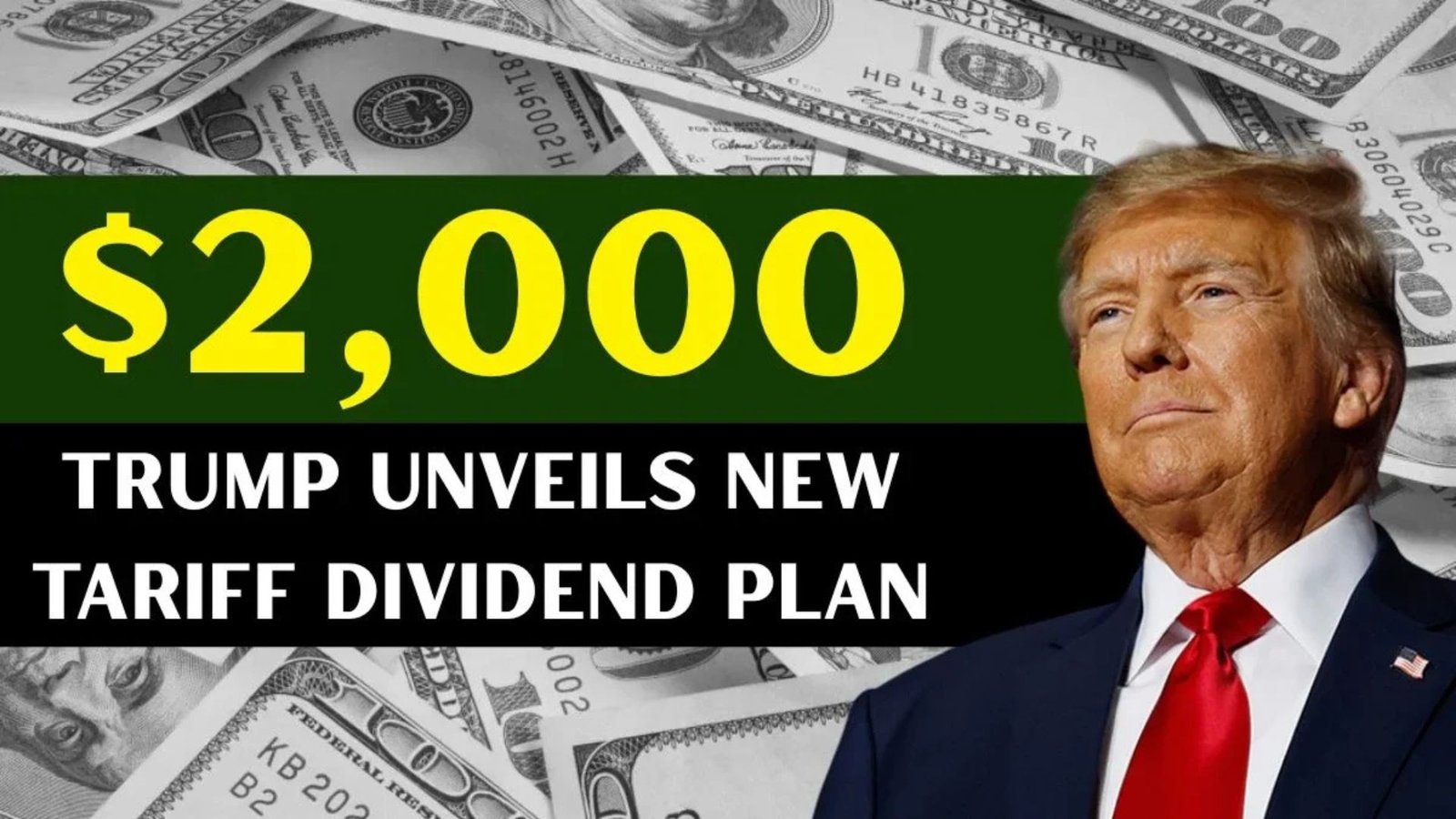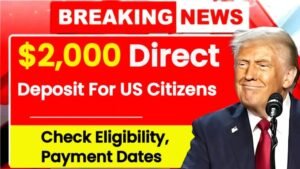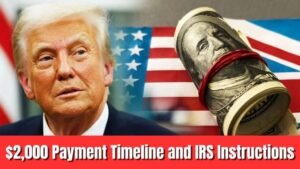In a bold move that’s got everyone talking, President Donald Trump recently promised to hand out $2,000 payments to most Americans straight from tariff money. Called a “tariff dividend,” this idea sounds like easy cash for families struggling with high prices. But is it real, or just hot air? In this fact-check on Trump’s $2,000 tariff dividend, we’ll break it down in plain English. We’ll look at what Trump said, why experts are skeptical, and if your wallet might see some extra green. Stick around—we’ve got the numbers, timelines, and a handy table to make it crystal clear.
If you’re wondering, “Will Trump give Americans $2,000 checks from tariffs?” you’ve come to the right place. This Trump tariff dividend fact-check dives deep, using fresh data from reliable sources. No fluff, just facts to help you decide if this promise holds water.
What Did Trump Say About the $2,000 Tariff Dividend?
Picture this: It’s a sunny Sunday morning, and Trump fires off a post on Truth Social. “People against tariffs are fools!” he writes. “We’re raking in trillions of dollars… A dividend of at least $2,000 a person (not including high-income folks!) will be paid to everyone.”
Simple breakdown: Tariffs are like extra taxes on stuff imported from other countries, like cars from China or steel from Europe. Trump says his big tariff push—kicked off on “Liberation Day” in April 2025—has flooded the government with cash. Now, he wants to share that “dividend” (think of it as a bonus payout, like getting a slice of company profits) with everyday Americans.
He didn’t spell out details, like who counts as “high-income” or when checks arrive. But later chats filled in some blanks. Trump told reporters the payments could hit mailboxes by mid-2026, maybe a bit later. And Treasury Secretary Scott Bessent chimed in: This might not be a straight check. It could morph into tax breaks, like no taxes on tips, overtime, or even car loans. Either way, the goal? Reward “middle-income and lower-income” families while slashing the nation’s $38 trillion debt.
Trump’s hyped this before. Back in October, he floated $1,000 to $2,000 checks. Now, with tariffs under fire at the Supreme Court, he’s doubling down. But hype aside, does the math add up?
The Real Scoop on Tariff Revenue: How Much Cash Is Flowing In?
Let’s get real about the money. Tariffs aren’t magic money trees—they’re fees U.S. companies pay when buying foreign goods. Those costs often get passed to you at the store, hiking prices on everything from phones to groceries.
Good news for Trump: Tariffs are bringing in bucks. The Treasury says they’ve pulled in $195 billion from October 2024 to September 2025—way up from $77 billion the year before. That’s a 153% jump, thanks to Trump’s broad tariffs on Canada, Mexico, China, and beyond.
But “trillions”? Not yet. Experts like John Ricco from Yale’s Budget Lab peg future yearly hauls at $200 billion to $300 billion tops. And remember, this cash isn’t free-floating—it’s already earmarked for things like cutting the deficit or funding a new GOP tax bill from July 2025.
Can Tariffs Really Fund $2,000 for Everyone? Expert Fact-Check Says No
Here’s where it gets tricky. Trump’s promise sounds great, but number-crunchers are waving red flags. This Trump $2,000 tariff dividend fact-check wouldn’t be complete without their take.
Erica York from the Tax Foundation crunched the numbers: If payments go to adults earning under $100,000 (about 150 million people), that’s $300 billion gone. Toss in kids? It balloons to $600 billion, per the Committee for a Responsible Federal Budget. Yet, net tariff revenue—after tariffs eat into other taxes—is just $90 billion so far.
Why the shortfall? Tariffs boost prices, which can slow the economy and cut income taxes. Plus, Trump’s team already promised this revenue for debt reduction. Handing out checks? That’d add to the debt, not shrink it.
Inflation watch: Past stimulus checks (like 2020’s) jacked up prices by 1-3%. More cash now could do the same, hurting the very folks Trump wants to help.
Legal snag? The Supreme Court grilled Trump’s tariff powers last week. Both sides seemed doubtful, and a loss could mean refunds to importers—wiping out billions.
Bessent admits: No chats with Trump yet, and Congress must greenlight any payout. As of November 20, 2025, it’s all talk, no action.
Pros and Cons of Trump’s Tariff Dividend Idea
To keep it balanced, let’s weigh the ups and downs. Tariffs aim to bring jobs home, but they’re no silver bullet.
| Aspect | Pros | Cons |
|---|---|---|
| Revenue Boost | $195B collected in 2025—real money for U.S. factories and investments. | Falls short of $300B+ needed for payments; “trillions” claim is hype. |
| Help for Families | $2,000 could ease bills for middle/low-income (under $100K?). | Excludes wealthy, but who qualifies? Kids included? Unclear rules. |
| Economic Impact | Might spark manufacturing boom, per Trump. | Raises prices on imports; could fuel inflation and hurt consumers. |
| Feasibility | Could tie into tax cuts (no tax on tips/overtime). | Needs Congress approval; Supreme Court risks refunds. |
| Timeline | Mid-2026 rollout promised. | No plan yet—experts call it a “stretch” or rebranded tax cut. |
This table shows why excitement meets caution. Sources like PolitiFact rate it “promising but problematic.”
Past Promises vs. Reality: Trump’s Track Record on Payouts
Trump loves big ideas. Remember 2020 stimulus? Checks flew out fast. But his first-term tariffs? They added $80 billion but spiked costs without massive job gains.
This dividend echoes a scrapped “DOGE” plan—cuts funded by Elon Musk’s ideas. It fizzled. Will this one stick? Only time (and Congress) will tell.
Bottom Line: Is the $2,000 Tariff Dividend a Go?
Trump’s $2,000 tariff dividend promise fires up voters tired of tight budgets. It’s a clever pitch: Punish trade rivals, reward Americans. But our fact-check on Trump’s tariff dividends reveals cracks. Revenue’s solid but not “trillions.” Costs outpace cash, and legal hurdles loom. As Bessent said, it might just be tax tweaks in disguise—no checks required.
By mid-2026? Possible, if stars align. For now, don’t spend it yet. Watch Congress and the Court. What do you think—game-changer or gimmick? Drop your thoughts below.



